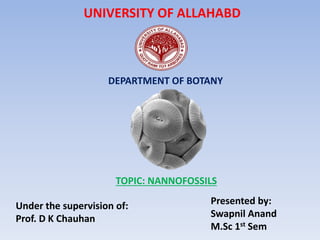
Nannofossils- Swapnil.pptx
- 1. UNIVERSITY OF ALLAHABD DEPARTMENT OF BOTANY TOPIC: NANNOFOSSILS Under the supervision of: Prof. D K Chauhan Presented by: Swapnil Anand M.Sc 1st Sem
- 2. INTRODUCTION • Calcareous nannofossils include the coccoliths and coccospheres of haptophyte algae and the associated nannoliths which are of unknown provenance. • The organism which creates the coccosphere is called a coccolithophore, they are phytoplankton. • Their calcareous skeletons are found in marine deposits often in vast numbers, sometimes making up the major component of a particular rock. • A coccolith is a single disc-like plate which is secreted by the algal organism and held in combination with several other, sometimes varying shaped plates by an organic coating to form the coccosphere. • On death the individual coccoliths invariably become separated and it is these that are most commonly preserved in the sedimentary record.
- 3. DIFFERENT FORMS Occasionally complete coccospheres are preserved and provide valuable information, particularly regarding coccospheres which possess two or more morphologicaly different coccoliths. There are two forms of coccoliths- • The holococcoliths which are formed from calcite crystals which are essentially identical in shape and size. • The heterococcoliths which are formed from larger calcite crystals which vary in size and shape. • Most living forms are known to produce only heterococcoliths and then only during the non-motile stage of their life cycle. Those that do produce holococcoliths do so only during their motile stage.
- 4. RANGE • First recorded occurrences of calcareous nannofossils (nannoliths) are from the late Triassic (Carnian). • The locations from which the earliest nannofossils are found include; the Northern and Southern Calcareous Alps, Timor, North-West Australia and Queen Charlotte Islands (Canada), all low latitude sites at the time. • There are many claims for earlier occurrences but a lack of substantiated evidence means these must be excluded. • One consequence of the first occurrence of calcareous nannofossils in the late Triassic lies in the fact that this was the first time open ocean planktonic organisms utilised calcareous skeletons and exported calcium carbonate into the deep oceans. • Today coccolithophores are one of the most important forms of phytoplankton found in the oceans, and may be described as the grass of the sea.
- 6. CLASSIFICATION • The classification of calcareous nannoplankton is carried out under the International Code of Botanical Nomenclature. • They are formally classified in the- Kingdom Protoctista, Phylum (or Division) Haptophyta, Class Prymnesiophyceae. • Classification is complicated by the fact that some species are dimorphic, that is they possess more than one coccolith on a single coccosphere. This may lead to the belief that two species exist where in fact there is only one. • Also, pleomorphism (where a holococcolith phase alternates with a heterococcolith phase) may also result in coccoliths being placed in different species or even genera when in fact they are simply different stages in the life cycle of the same species.
- 7. LIFE CYCLE • The chief reproductive mode of coccolithophores is asexual by mitotic division through which the coccoliths are redistributed amongst the daughter cells. • In some haptophytes complex life cycle is demonstrated involving two or more morphologically distinct phases. • A typical coccolithophore life cycle consist of a diploid stage, which is covered by heterococcoliths. • Alternation of life cycle has been demonstrated in culture studies. No conclusion data is drawn about the causative factors controlling the trigger of phase change.
- 9. APPLICATION As the groups name suggests calcareous nannofossils are small, generally less than 30 microns across and usually between 5 and 10 microns (individual coccoliths). This has advantages and disadvantages. Advantages include: • Good preservation, their small size makes mechanical damage unlikely. • Widespread distribution, as part of the phytoplankton coccolithophores are distributed throughout the photic zone (predominantly the upper 50m of the water column) across almost all marine habitats. • A very large number of individual coccoliths may be preserved in a tiny amount of sediment hence only very small quantities of sample are needed to produce statistically valid results.
- 10. Disadvantages include: • Because of dissolution of calcium carbonate at depth in sea water (called the carbonate compensation depth (CCD)), preservation is compromised in deep water sediments. • Because of their small size and resistance to mechanical breakdown nannofossils can be reworked, great care is therefore needed especially when utilising nannofossils for biostratigraphic studies. • Again, because of the small size the opportunities for contamination are high, although careful and thorough preparation and collection techniques should significantly reduce this risk.
- 11. FUNCTION OF COCCOLITHS Coccoliths supposedly shield the enclosed cell from excessive sunlight, or concentrate light towards cell centre due to convexo-concave shape of coccoliths. Other varied functions are floating devices, metabolic barriers, stabilizers, defensive shields etc. Some biologists are of the opinion that coccoliths are by product of detoxification of carbonate through the fixation of calcium.
- 12. Triassic & Jurassic Nannofossils Anulasphaera helvetica Biscutum novum Crucirhabdus minutus
- 13. Lower cretaceous nannofossils Nannoconus abundans Eprolithus floralis Calcicalathina oblongata
- 14. Upper cretaceous nannofossils Tranolithus orionatus Micula staurophora Eiffellithus eximius
- 15. Discoaster tanii Chiasmolithus solitus Palaeogene nannofossils
- 16. Neogene nannofossils Coccolithus pelagicus Calcidiscus tropicus
